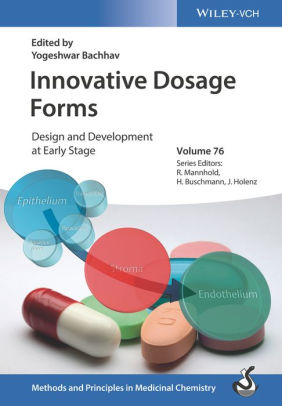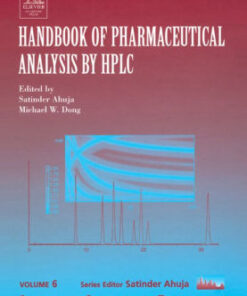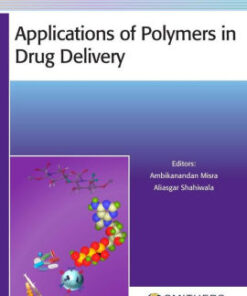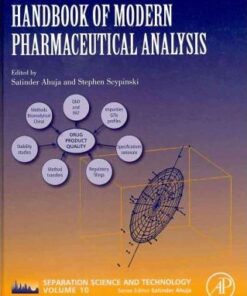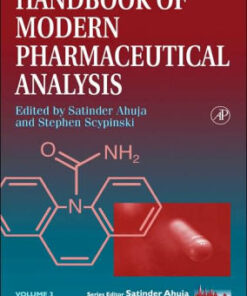(PDF) Innovative Dosage Forms – Design and Development by Yogeshwar Bachhav
$18.00
Download instantly Innovative Dosage Forms – Design and Development at Early Stage by Yogeshwar Bachhav, Raimund Mannhold, Helmut Buschmann, Jrg Holenz. It is ebook in PDF format.
ISBN-10: 3527343962 ISBN-13: 9783527343966
Preview
This is the PDF eBook version for Innovative Dosage Forms – Design and Development at Early Stage by Yogeshwar Bachhav, Raimund Mannhold, Helmut Buschmann, Jrg Holenz
Table of Contents
Preface xvii
1 Impact of the Polymorphic Form of Drugs/NCEs on Preformulation and Formulation Development 1
MHD Bashir Alsirawan and Anant Paradkar
1.1 Introduction 1
1.1.1 Background 1
1.1.2 Types of Polymorphism 2
1.1.3 Thermodynamic-Based Classification of Polymorphism 4
1.1.4 Concomitant Polymorphism 6
1.1.5 Debatable Polymorphism Cases 7
1.2 Polymorphism Impact on Drug/Excipient Properties 9
1.2.1 Physicochemical Properties 10
1.2.2 Mechanical Properties 11
1.2.3 Impact of Polymorphism on In Vivo Performance 13
1.3 Critical Impact of Polymorphic Form of API on Processing and Formulation 22
1.3.1 Process-induced Transformation Types 23
1.3.1.1 Grinding-induced Transitions 23
1.4 Conclusion 37
References 38
2 Strategies for the Formulation Development of Poorly Soluble Drugs via Oral Route 49
Sanket Shah, Abhijit Date, and Renè Holm
2.1 Introduction 50
2.2 Quality by Testing (QbT) and Quality by Design (QbD) 50
2.3 Linking the Formulation to the Clinical Phase 52
2.4 Defining the Formulation Strategy 55
2.5 Nanosuspensions 58
2.5.1 Description 58
2.5.2 Method of Manufacturing 59
2.5.3 Characterization of Nanosuspensions 63
2.6 Solid Dispersion 64
2.6.1 Description 65
2.6.2 Method of Manufacturing 66
2.6.3 Characterization 68
2.7 Lipid-Based Drug Delivery Systems 69
2.7.1 Description 70
2.7.2 Method of Manufacture 71
2.7.3 Characterization 75
2.7.4 Role of API Property on Lipid-Based DDS 76
2.8 Micellar System 76
2.8.1 Description 76
2.8.2 Formulation Development and Optimization 80
2.8.3 Characterization 81
2.9 Mesoporous Silica Particles 81
2.9.1 Description 82
2.9.2 Method of Manufacturing and Characterization 83
2.9.3 Case Study on the in Vivo Efficacy of Mesoporous Silica Particles 84
2.10 Conclusion 84
References 85
3 Effect of Residual Reactive Impurities in Excipients on the Stability of Pharmaceutical Products 91
Ankit Sharma
3.1 Introduction 91
3.2 Reactive Impurities in the Excipients and Their Impact on Drug Stability 92
3.3 Impact of Reactive Impurities on Drug–Excipient Compatibility 93
3.3.1 Physical Interactions 93
3.3.2 Chemical Interactions 94
3.3.3 Oxidative Degradation 94
3.3.4 Peroxides 95
3.3.5 Transition Metal Impurities 96
3.3.6 Condensation Reactions 99
3.3.7 Aldehyde Impurities 99
3.3.8 Reducing Sugars 102
3.3.9 Organic Acids 103
3.3.10 Hydrolytic Degradation 105
3.4 Risk Assessment for API Incompatibilities and Mitigation Strategies 107
3.5 Assessment of Incompatibilities of API with Excipients 108
3.6 Design and Selection of Drug Substance 109
3.7 Formulation Strategies to Circumvent API Degradation 110
3.8 Inhibition of Oxidative Degradation 110
3.8.1 Initiation Inhibitors 111
3.8.2 Propagation Inhibitors 111
3.8.3 Selection of Antioxidant 112
3.9 Super-Refined Excipients 113
3.9.1 Polyethylene Glycols (PEG) 114
3.9.2 Polysorbates 114
3.9.3 Fatty Acids 115
3.10 Packaging and Storage 115
3.11 Concluding Remarks 116
References 116
4 Preclinical Formulation Assessment of NCEs 119
Raju Saka, Priyadarshini Sathe,Wahid Khan, and Sachin Dubey
4.1 Introduction 120
4.2 Significance of Various Properties of NCEs in Early Drug Discovery 122
4.2.1 Solubility 123
4.2.2 Permeability 124
4.2.3 Stability 125
4.3 Formulation Strategies to Improve Properties of NCEs 125
4.3.1 pH Modification 127
4.3.2 Cosolvents 127
4.3.3 Cyclodextrins 128
4.3.4 Surfactants 128
4.3.5 Suspensions and Nanosuspensions 129
4.3.6 Emulsions and Microemulsions 130
4.3.7 Solid Dispersions 130
4.3.8 Liposomes 131
4.4 Preclinical Formulation Assessment of Oral, Parenteral, and Topical Dosage Forms 131
4.4.1 Oral Formulations 131
4.4.2 Parenteral Formulations 134
4.4.3 Topical Formulations 135
4.4.4 Excipients 138
4.4.5 Characterization and Stability of Preclinical Formulations 140
4.4.6 Formulation Selection for Pharmacokinetic Studies 141
4.4.7 Formulation Selection for Pharmacodynamic Studies 142
4.4.8 Formulation Development for Toxicity Studies 142
4.5 Case Studies 143
4.5.1 Case 1: Use of Surfactant to Prevent Precipitation of API in Cosolvent-Based Formulations 143
4.5.2 Case 2: Topical Gel Microemulsion Formulation of Lipophilic Drug WHI-07 144
4.5.3 Case 3: Salt Approach to Improve the Bioavailability of the Poorly Soluble Drug 144
4.5.4 Case 4: Use of SMEDDS Dosage Form to Improve Bioavailability 145
4.5.5 Case 5: Micronized Suspension of Poorly Soluble Lead Compounds Using Wet Milling Technique 145
4.5.6 Case 6: Polymer Addition in Cyclodextrin-Based Formulations and pH Adjustment 146
4.5.7 Case 7: Cyclodextrin Complexation to Improve Topical Delivery of a Poorly Soluble Compound 146
4.5.8 Case 8: Use of Solublizers and Their Effect on PK of Preclinical Lead Candidates 147
4.5.9 Case 9: Self-nanoemulsifying Drug Delivery Systems (SNEDDS) to Improve Solubility and Bioavailability 147
4.6 Conclusion and Future Perspectives 148
References 148
5 Regulatory Aspects for Formulation Design – with Focus on the Solid State 155
Michael Gruss
5.1 The Understanding of “Regulatory” 156
5.2 Formulation Design 157
5.3 An Extended Timescale 158
5.4 Solubility Data 158
5.5 Impact of Solubility and Dissolution Rate on Formulation Design 162
5.6 Single and Multicomponent Systems 163
5.6.1 Introduction 163
5.6.2 Scientific Point of View 164
5.6.3 Fate and Pathway of a Compound During Development 166
5.6.4 Regulatory Point of View 167
5.7 Analytical Techniques for the Characterization of the Solid State 168
5.7.1 Scientific Literature 168
5.7.2 Pharmacopeias 169
5.8 Control of Solid-state Constitution 171
5.8.1 The Process – from Synthesis to Patient 171
5.8.2 Change of Properties and Constitution 173
5.8.3 Need for Control of Solid-State Properties During the Process and Supply Chain 173
5.9 Regulatory Consideration of Solid Compounds 174
5.9.1 Definitions for Solid Compounds 174
5.9.2 Common Technical Document (CTD) – M4Q 175
5.9.3 Guideline on the Chemistry of Active Substances 178
5.9.4 Guideline on Quality of Transdermal Patches 180
5.9.5 Quality Guidelines 181
5.9.6 EMA – Consideration and Perspective 188
5.9.7 FDA – Consideration and Perspective 190
5.9.8 Similarities and Differences Between the Regulative Systems in the EU and United States 197
5.10 Conclusions and Recommendations 198
Disclaimer 198
References 198
6 Insight into Innovative Applications of Parenteral Formulations 209
Clara Fernandes
6.1 Introduction 209
6.2 Factors Affecting Development of Sustained-/Controlled-Release Formulations 209
6.3 Overview of Sustained and Controlled Release Parenteral Formulations 213
6.3.1 Suspension Based Formulations 213
6.3.2 Particulate System Based Formulations 215
6.4 Case Studies 219
6.4.1 Nanosuspension Formulation of Paclitaxel – Abraxane® 219
6.4.2 PLGA Depot Based Formulation of Triptorelin – Trelstar® 219
6.4.3 Microemulsion Formulation of Propofol 220
6.4.4 Inorganic Metal Nanoparticle Based Formulation for Parenteral Applications 220
6.4.5 Polymeric Formulation of Glatiramer 221
6.5 Conclusion 222
6.6 Future Prospects 222
References 222
7 Assessing Pharmacokinetics of Various Dosage Forms at Early Stage 227
Susanne Bonsmann and Joachim Ossig
7.1 Introduction 227
7.2 Definition of Pharmacokinetics 229
7.2.1 ADME Parameters 229
7.2.2 Pharmacokinetic Parameters 231
7.2.3 PK Studies During Drug Development 236
7.3 Case Studies 241
7.3.1 Case Study 1 241
7.3.2 Case Study 2 241
7.3.3 Case Study 3 242
7.3.4 Case Study 4 243
7.4 Summary 243
References 243
8 Transdermal Medical Devices: Formulation Aspects 245
Mayank Singhal, César E. S. Jimenez, Maria Lapteva, and Yogeshvar N. Kalia
8.1 Introduction 246
8.2 Microneedles 247
8.2.1 Delivery Using Solid Microneedles: Skin Pretreatment 248
8.2.2 Delivery Using Coated Microneedles 252
Challenges Related to the Formulation of Coated Microneedles – A Case Study 252
8.2.3 Delivery Using Dissolvable Microneedles 254
8.2.4 Delivery Using Hollow Microneedles 255
8.2.5 Delivery of Vaccines 257
8.2.6 Modalities of Microneedle Use 259
8.2.7 Perspectives in Microneedle-Mediated Transdermal Delivery 259
8.3 Laser-Assisted Ablation: Skin Pretreatment 260
8.3.1 Laser–Skin Interaction 261
8.3.2 Formulation Aspects 262
8.3.3 Perspective 263
8.4 Iontophoresis 263
8.4.1 Clinical Benefits of Iontophoresis in Transdermal/Topical Delivery 264
8.4.2 Selection of Drug Candidates 265
8.4.3 Iontophoretic Device Formulation Characteristics: Compositions and Challenges 265
8.4.4 Earlier Approved Commercial Devices 266
8.4.5 Smart Ionto System Features 268
8.4.6 Perspectives 269
References 269
9 Physical Characterization Techniques to Access Amorphous Nature 281
Aniket Sabnis, Niten Jadav, TimGough, Adrian Kelly, and Anant Paradkar
9.1 Introduction 282
9.1.1 Limitations of the Amorphous Form 285
9.1.2 Stabilization of the Amorphous Form 285
9.1.3 Solid Dispersion 285
9.1.4 Factors Affecting Solubility of API in the Form of Solid Dispersions 287
9.1.5 Limitations 289
9.1.6 Co-Amorphous 289
9.2 Screening Techniques for Amorphization 290
9.2.1 Amorphization: Solution-Based Techniques 291
9.2.2 Amorphization: Solid-State Techniques 294
9.3 Characterization of Amorphous Materials 298
9.3.1 X-Ray Powder Diffraction (XRPD) 299
9.3.2 Thermal Methods 302
9.3.3 Perfusion/Solution Calorimetry 307
9.3.4 Density Measurements 310
9.3.5 Sorption Technique: Dynamic Vapor Sorption (DVS) 310
9.3.6 Vibrational Spectroscopy 312
9.4 Summary 321
9.5 Future Prospects 322
References 323
10 Design and Development of Ocular Formulations for Preclinical and Clinical Trials 331
Mathieu Schmitt
10.1 Introduction 331
10.2 Ocular Anatomy and Physiology 332
10.3 Ocular Routes of Administration 336
10.4 Drug Discovery in Ophthalmology 337
10.4.1 Repositioning of Existing Drugs from Other Disease Area 337
10.4.2 Optimization of Compound Class to Enhance Selectivity, Tolerance Profile, and Efficacy 338
10.4.3 Specific Development 339
10.5 Topical Drug Administration 340
10.5.1 Ocular Bioavailability 340
10.5.2 Drug Design 340
10.5.3 Prodrugs 342
10.5.4 Physiological Factors 343
10.5.5 Formulation and Drug Delivery Systems 344
10.5.6 Patient Compliance Through Packaging 354
10.6 Posterior Segment Delivery 356
10.6.1 In Situ Depot 357
10.6.2 Prodrugs 357
10.6.3 Intraocular Implants/Microparticles 358
10.7 Conclusion 360
References 361
11 Preclinical Safety Aspects for Excipients: Oral, IV, and Topical Routes 367
Florian Engel
11.1 Introduction 368
11.2 General Considerations 369
11.3 Undesired Side Effects of Excipients 370
11.4 Novel Excipients 371
11.4.1 Regulatory Requirements 372
11.5 Rationale in Selecting an Excipient 375
11.5.1 Data Sources 376
11.5.2 Strategies to Determine “Estimated Safe Excipient Doses” 378
11.5.3 Special Considerations for Oral Use 381
11.5.4 Special Considerations for Intravenous Use 381
11.5.5 Special Considerations for Topical Use 385
11.6 Conclusions 386
References 387
12 Formulation of Therapeutic Proteins: Strategies for Developing Oral Protein Formulations 391
Saurabh Patil, Aditya Narvekar, Amita Puranik, Ratnesh Jain, and Prajakta Dandekar
12.1 Introduction 392
12.1.1 Use of Proteins for Different Therapeutic Indications 392
12.1.2 Importance of Physicochemical Properties on Preformulation and Formulation Development of Protein Therapeutics 394
12.1.3 Stability Constraints and Formulation Challenges 395
12.1.4 Current Market Status and Opportunities of Therapeutic Proteins 396
12.1.5 Current Technologies for Protein Formulation Development 398
12.1.6 Current Approaches in Oral Delivery of Proteins for Enhanced GIT Absorption 400
12.2 Types of Proteins Used in Therapeutic Indications 400
12.3 Important Physicochemical Properties of Proteins for Formulation Development 402
12.4 Existing Route of Administrations of Protein Formulations 404
12.5 Developmental Aspects of Oral Protein Formulations 405
12.5.1 Resource Requirements for Manufacturing of Protein-Based Formulations 406
12.5.2 Stability Concerns of Proteins in the Gastrointestinal Tract (GIT) 407
12.5.3 Physical Barriers to Delivering Proteins and Peptides 407
12.5.4 Formulation Strategies for the Oral Delivery of Proteins and Peptides 409
12.5.5 Modification of the Physicochemical Properties 411
12.5.6 Use of Particulate Formulations 412
12.5.7 Colon-Targeted Delivery Systems for Proteins and Peptides 416
12.5.8 Mucoadhesive Polymeric Systems and Stimuli-Responsive Hydrogels 417
12.5.9 Cell-Penetrating Peptides 417
12.5.10 Prodrug Approach 417
12.6 Clinical Application of Oral Protein Formulations 418
12.7 Case Studies of Oral Protein Formulations 418
12.7.1 Case Study I: Cyclosporine A 418
12.7.2 Case Study II: Oral Insulin 421
12.7.3 Case Study III: Prodrug Approach – Desmopressin 422
12.8 Conclusion 422
References 423
Index 433
